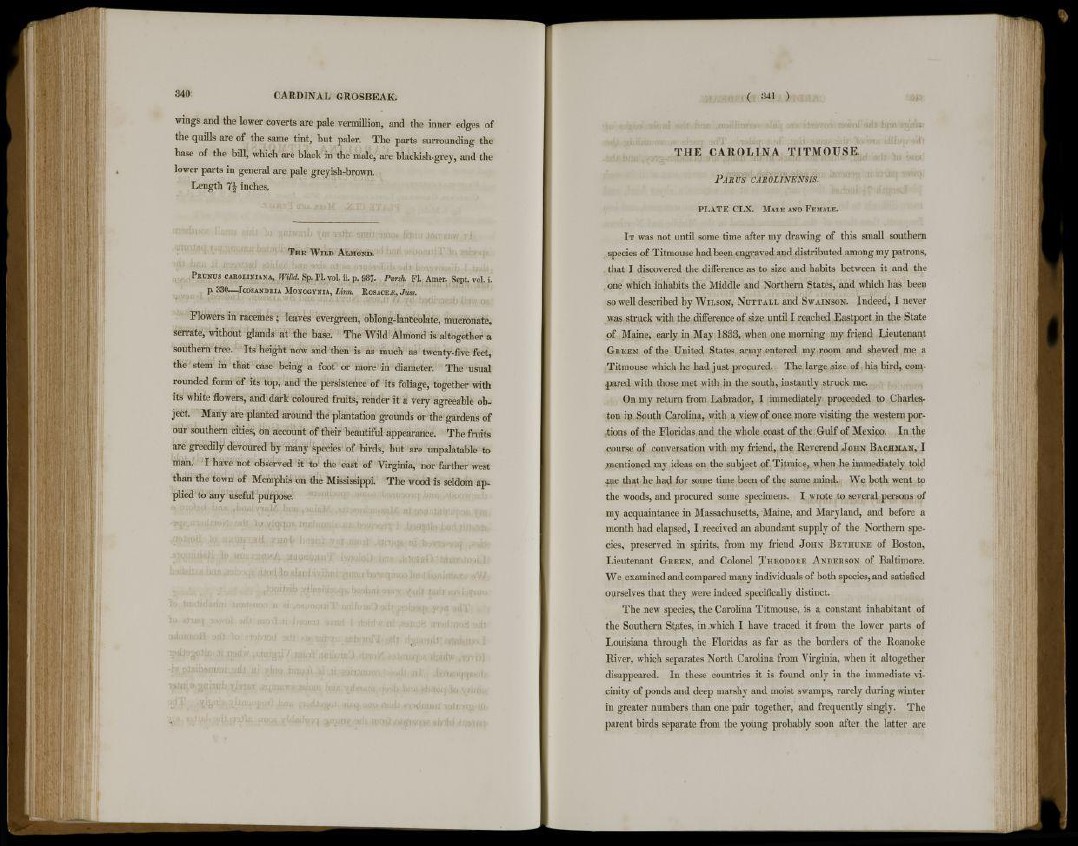
340 C A R D I N A L G R O S B E A K .
wings and the lower coverts are pale vermillion, and the inner edges of
the quills are of the same tint, but paler. The parts surrounding the
base of the bill, which are black in the male, are blackish-grey, and the
lower parts in general are pale greyish-brown.
Length 7 | inches.
THE WILD ALMOND.
PRUNUS CAROLINIANA, Willd. Sp. PI. vol. ii. p. 987- Pursh, Fl. Amer. Sept. vol. i.
p. 330—ICOSANDRIA MONOGYNIA, Linn. ROSACEA, JUSS.
Flowers in racemes ; leaves evergreen, oblong-lanceolate, mucronate,
serrate, without glands at the base. The Wild Almond is altogether a
southern tree. Its height now and then is as much as twenty-five feet,
the stem in that case being a foot or more in diameter. The usual
rounded form of its top, and the persistence of its foliage, together with
its white flowers, and dark coloured fruits, render it a very agreeable object.
Many are planted around the plantation grounds or the gardens of
our southern cities, on account of their beautiful appearance. The fruits
are greedily devoured by many species of birds, but are unpalatable to
man. I have not observed it to the east of Virginia, nor farther west
than the town of Memphis on the Mississippi. The wood is seldom applied
to any useful purpose.
( 341 )
T H E C A R O L I N A T I T M O U S E .
PARUS CAROLINENSIS.
P L A T E C L X . MALE AND FEMALE.
IT was not until some time after my drawing of this small southern
species of Titmouse had been engraved and distributed among my patrons,
that I discovered the difference as to size and habits between it and the
one which inhabits the Middle and Northern States, and which has been
so well described by WILSON, NUTTALL and SWAINSON. Indeed, I never
was struck with the difference of size until I reached Eastport in the State
of Maine, early in May 1833, when one morning my friend Lieutenant
GREEN of the United States army entered my room and shewed me a
Titmouse which he had just procured. The large,size of his bird, compared
with those met with in the south, instantly struck me.
On my return from Labrador, I immediately proceeded to Charleston
in South Carolina, with a view of once more visiting the western portions
of the Floridas and the whole coast of the Gulf of Mexico. In the
course of conversation with my friend, the Reverend JOHN BACHMAN, I
mentioned my ideas on the subject of Titmice, when he immediately told
.me that he had for some time been of the same mind. We both went to
the woods, and procured some specimens. I wrote to several persons of
my acquaintance in Massachusetts, Maine, and Maryland, and before a
month had elapsed, I received an abundant supply of the Northern species,
preserved in spirits, from my friend JOHN BETHUNE of Boston,
Lieutenant GREEN, and Colonel ^THEODORE ANDERSON of Baltimore.
We examined and compared many individuals of both species, and satisfied
ourselves that they were indeed specifically distinct.
The new species, the Carolina Titmouse, is a constant inhabitant of
the Southern States, in .which I have traced it from the lower parts of
Louisiana through the Floridas as far as the borders of the Roanoke
Jliver, which separates North Carolina from Virginia, when it altogether
disappeared. In these countries it is found only in the immediate vicinity
of ponds and deep marshy and moist swamps, rarely during winter
in greater numbers than one pair together, and frequently singly. The
parent birds separate from the young probably soon after the latter are